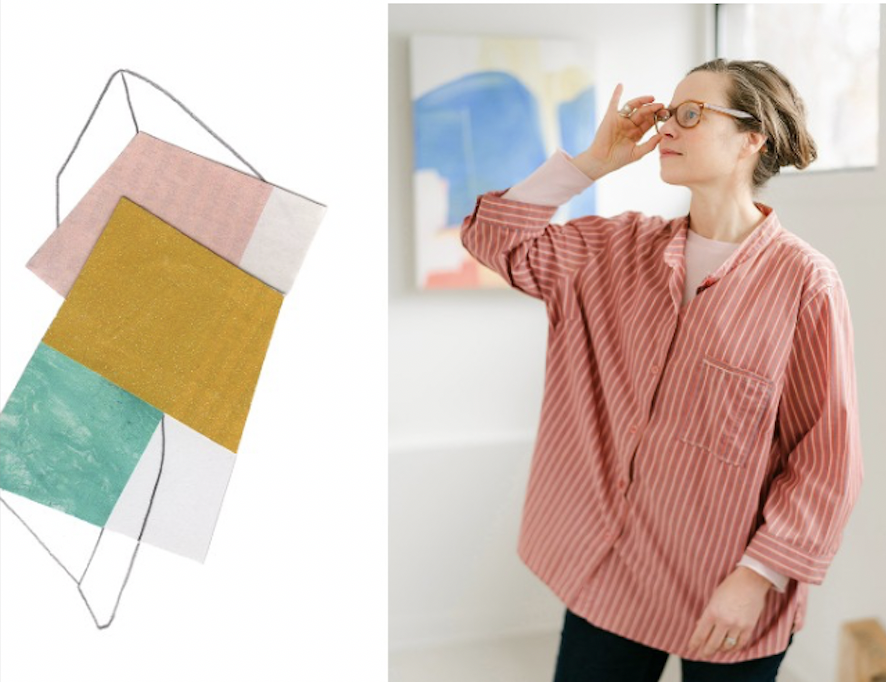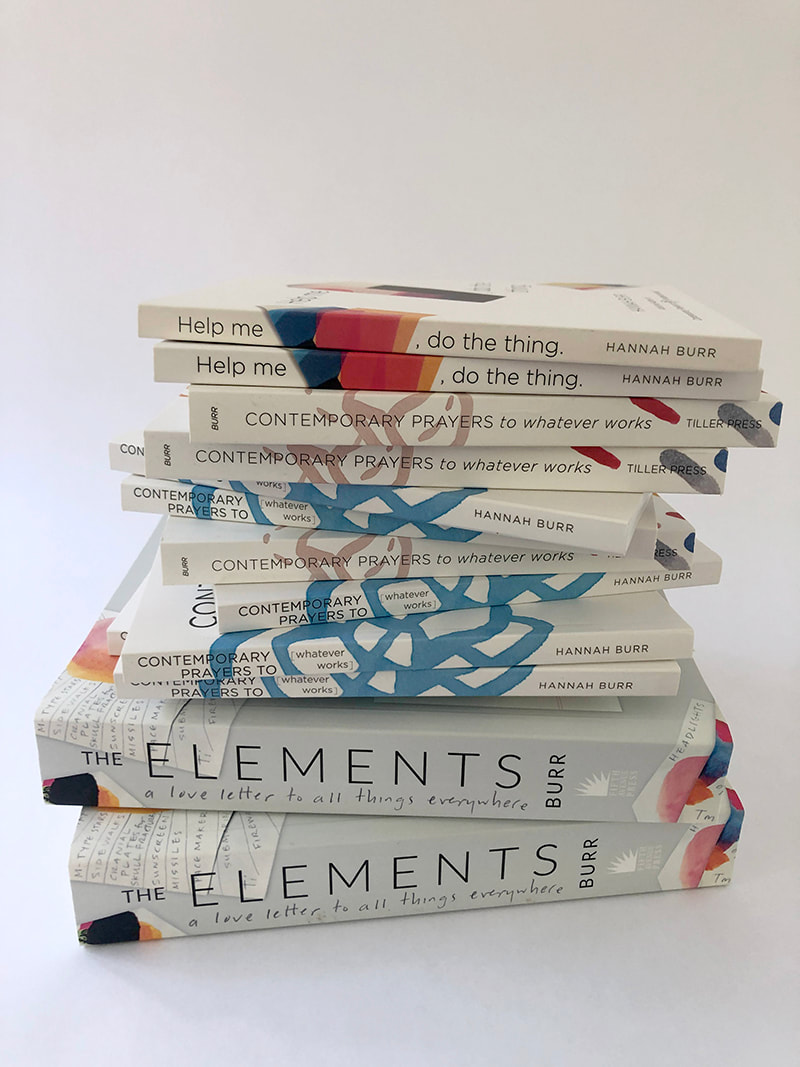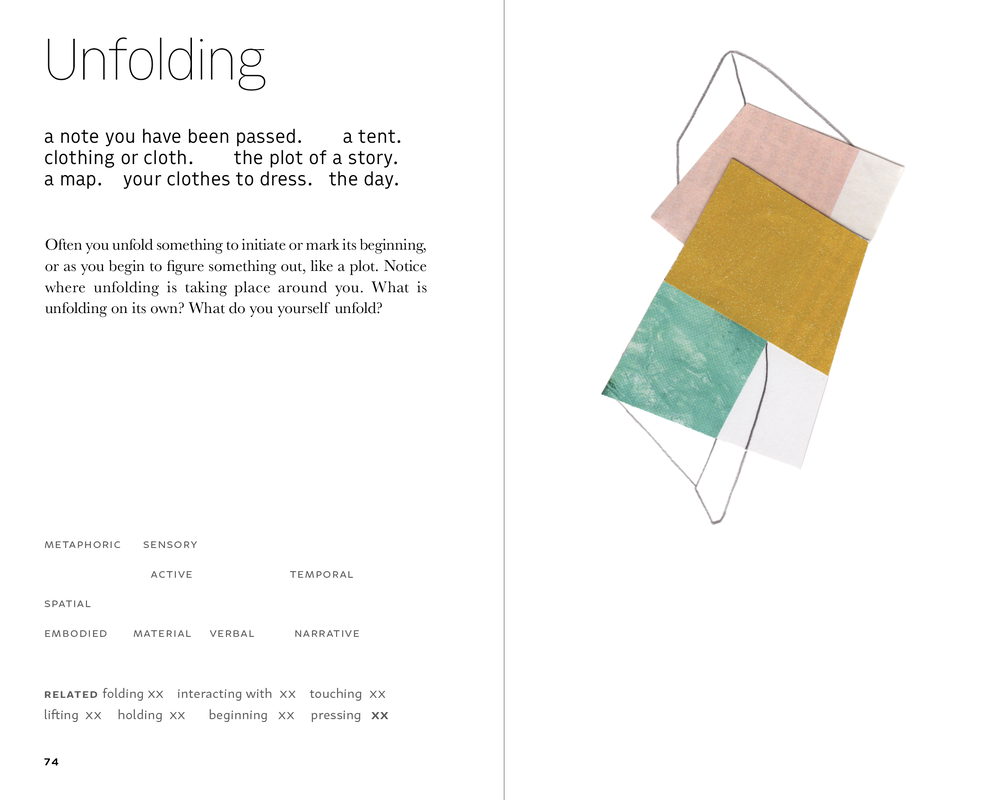|
by Christopher Porter Tue, 06/06/2023 - 3:30pm A FIELD GUILD TO HANNAH BURR: THE ANN ARBOR ARTIST CREATES ABSTRACT WORKS THAT CONJURE CONTEMPLATION From PULP Online Magazine Hannah Burr's art seeks to foster connections, not only between the viewer and the work but also between the viewer and the universe. The Ann Arbor artist works in everything from painting and drawing to sculpture and books, but no matter the medium, Burr's art acts as a prompt for observers to consider how they relate to the world around them and beyond. Burr's dedication to contemplative matters is perhaps best shown in her series of books, such as Contemporary Prayers to * [whatever works] and Elements: a love letter to all things everywhere, which marry aphorisms or scientific facts with abstract paintings and ask readers to observer how they feel when taking in the words, colors, and shapes on the page. Her forthcoming book, Field Guide to Ambiguity, is currently in its Kickstarter phase, and like Elements, is coming out via Fifth Avenue Press, the Ann Arbor District Library's publishing imprint. This follows a 2021 expanded and completely reworked version of Contemporary Prayers, which was published by Simon & Schuster. Burr is one of more than 80 artists who will display her works at the West Side Art Hop, held annually in Ann Arbor's historic Old West Side. This year's Art Hop runs June 10 and 11; a map of the home/garage/yard venues can be found here, but Burr will be at 701 5th Street. I caught up with Burr ahead of the West Side Art Hop as she preps Field Guide to Ambiguity and other projects, many of which she documents in her well-maintained blog, Good Bonfire. Q: Where did you grow up and what brought you to Ann Arbor? A: I grew up in Boston, Massachusetts, and mostly lived just there until 2017. I married an Ann Arborite and did the covered-wagon thing like many Midwesterners before me, bringing my home and studio here. Q: I saw that you graduated from Brown with degrees in fine art and religious studies. Has your artwork always been informed by the mystic and metaphysical? A: In a sense, yes. When I first graduated, a mentor suggested I just focus on one thing, and I chose landscape as my subject for a month. Landscape remains one of the mainstays of my visual art over 20 years later. Over time, however, my interests in philosophy and poetic expression leaked into that simple endeavor and I began drawing landscapes in pen on envelopes where the main address goes, sending these out with postage stamps. These mail drawings then were returned to me "for better address." This stack of mail drawings became my first conceptual project: a stack of artwork sent through the mail called Field Notes, investigating "when writing becomes drawing." The drawing activity was a form of inquiry, and the landscape I drew felt like the response. In a sense, yes, even when I tried to keep it to simple landscape, my work often became about something more metaphysical. For what it's worth, I consider myself a philosopher expressing ideas through art media. Q: Artists generally like to have reactions to their works, but your art seems to exist specifically to inspire viewers to find out what it sparks inside themselves—emotions, memories, place in the universe—rather than just invoking an aesthetic appreciation or experience. A: That's an interesting observation. I think, in a sense, of my work as having its own kind of presence—a potential, perhaps, that wakes up the same alive quality in someone encountering it, if it resonates with that person. I don't plan this, but over time, I suppose I've observed that to be the case. That may be the case with all artwork: the greater the mutual resonance, the more an artwork succeeds. Lately, I've been thinking of my individual artworks playing a role a little like a talisman, a mezuzah, a blessing, or a clearing-type object for the spaces where they hang. Q: How has your working process for these books changed over the years? Do you write the prayers and then do the art or is it more of a simultaneous creative endeavor? A: My very first book was in 2013 and was called Contemporary Prayers to * [whatever works]. The second in 2016 was called Help me [ ], do the thing, and the final in the series confusingly has the same name as the first with simpler punctuation in the title: Contemporary Prayers to Whatever Works, from 2021. This last one is a new book in the series, published by Simon & Schuster, based on the artwork and the concept of the first book, but all new artwork and prayers—distinct from the first. I make the artwork on its own, initially just playing around in my studio, and develop a concept for the book concurrently. Once I understand what artwork will work best, I often take a small initial selection of artwork and expand upon it, while developing and refining the concept separately. In combining them, further insights lead to refinements. Because the artwork is as important as the text, I finish editing the book with the visual layout in place. Q: Tell us about your upcoming book, Field Guide to Ambiguity, and how does it fit in with your other books? A: This is a book that feels appropriate for the world we're living in right now. It's a guide to free fall or to being human: not knowing what will happen next. Each "specimen page" is an ambiguous situation, it's variations and a brief contemplation. It's a practical and poetic way to reframe and reorient yourself to the specifics of your situation, with prompts for journalling, indexes and directories to find your way around. In some ways the premise of the book is ridiculous: How could ambiguity be classified? And the punchline is that in many ways you yourself are the most ambiguous thing of all. I intend for this book to be useful as an orienteering tool, without being prescriptive, specifically for when you are in life's washing machine and it's hard to feel grounded or centered. It's full of questions to ask that don't really require answers but can help you to rest in the middle of the unknown, a natural and intimate, ever-present backdrop to everything. The Field Guide to Ambiguity began about 10 years ago with the title, just when I was starting to immerse myself in field guides for rocks and birds as a hobby. Sometimes a phrase shows up for me that has real power but I don't know what to do with it. This happened years before the first book of prayers, when I heard this phrase while I was drawing one day: "I will always be the tree in your yard." I wrote this down, and many years later, this remembered phrase became the prayer, "Thank you for being the tree in my yard and the chair that I'm sitting in," a page from the first Contemporary Prayers book. The title Field Guide to Ambiguity came to me in a similar way, and first had me breaking down the structure of a field guide to understand what it was, and how it might apply to all of the ambiguous situations in our lives. Similarly to the Elements: a love letter to all things everywhere, my third book, there's a creative reframe of something scientific the Field Guide to Ambiguity. In Elements, it was a new lens on each element; in Field Guide, it's a new lens on the field guide structure itself, and an invitation, repeated throughout the book, to see for yourself how things are, to observe, note, and explore your direct perception of a situation, the familiar, and the objects around you, much like in Elements there's an invitation to find the elements in the tangible objects of the world. Like all of my other books, the structure of this book is lateral, meaning that you can open to any page as a starting place, and it doesn't have to be read linearly. Also, there's a series of more than 80 color works in the book, so you can approach the book visually, conceptually, or like a book of poems. Like the last book elements, there are several indexes and directories, so that you always feel oriented and able to navigate through this nebulous subject, and the images are minimal and colorful, with lots of space around them, so the concepts have space for real reflection. Unlike the other books, there are several essays in this book. Q: Contemporary Prayers to Whatever Works was picked up by a major publisher in Simon & Schuster. What made you decide to return to semi-self-publishing and Fifth Avenue Press for Field Guide to Ambiguity? A: While I had a positive experience receiving an advance and having others print, pay for, and house the books with a big publisher, I found it pretty unsatisfying to have to buy my own books like a retailer, and that the sales reps tend to focus on their cash cows like Stephen King while having no real investment in selling the book of such a small fry like me. When I do my own printing through a crowdfund like I'm currently doing with Field Guide to pre-sell books as the way to bring the book to print without going into debt, it's definitely work up front. But I end up with the book file, final sign-off, and a whole community to help build the book and whatever books I raise the money to print, to do with as I like. This way, I learn more about how the book is valued, perceived, and who my community is, and those who back the project get their name in the book, to invest in it from day one before it's printed, and we are in direct contact with no middleman. A very valuable added bonus is to have AADL's very own press support it with input from a designer, some publicity, and an editor, right in my own town! Again, it feels much more about human relationships this way, than about a massive institution giving me some kind of gold star of approval but not a lot of follow-up support, and fewer sales than when I do it myself. Q: In addition to your books, what are the sorts of works you'll have on sale at West Side Art Hop? A: In addition to original paintings and drawings of my own—landscape and pure abstraction—and the books, I will be sharing the gorgeous and technically complex prints of Ann Arbor artist Janet Gallup, who lived here, had her studio and family here, and died here at age 67 [in 1991]. I have been archiving and photographing her remaining serigraph prints for our dear friend Al Gallup, who did his very best to care for her remaining work and is now 96, one of the oldest continuing, lifelong residents of Ann Arbor—who still occasionally rides his bike and makes cookies for my husband! This will be the first time I share her works for sale, and I'm really excited about this! I will also be sharing a short run of letterpress cards for the first time, and through Sunday, June 11, for anyone who backs my crowdfund, doing a giveaway of a set of five of these limited-run cards as a thank you for reserving the upcoming books. I will be showing alongside Lynda Cole (prints and paintings), Monika Rykoff-Wilson (ceramics and photos), Cathryn Amidei (fiber/textile art) and Valerie Mann (paintings, cards). We'll be at 701 5th Street under the colorful painted garage of Cathryn Amidei, 10 am to 5 pm on Saturday and 12 pm to 5 pm on Sunday. To see more images and learn more about the upcoming book, visit bit.ly/fieldguidetoambiguity. Christopher Porter is a library technician and the editor of Pulp.
0 Comments
|
ALIVEUPCOMING AND RECENT
FIELD GUIDE TO AMBIGUITY is here! Arrived Jan 31 NOW--ISH A solo exhibition Opening June 7—Sept 6 2024, Saugatuck Center for the Arts, Saugatuck MI. FREE SESSION WITH HANNAH!If you feel overwhelmed, confused or just plain excited by what's afoot in your life, and would like some excellent clarifying space and tools, try a session with Hannah! She's been a coach for 15 years. First 30 minutes is just to see what it's like...
AuthorHannah Burr is a contemporary artist and author. Originally from Boston, she lives in Ann Arbor MI. Archives
November 2023
Categories
All
|



 RSS Feed
RSS Feed